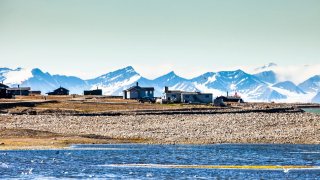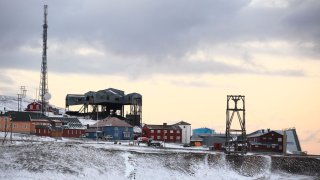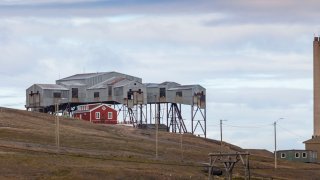Statistikk innhold
Statistics about
Industry statistics for Svalbard
The statistics provide insight into the development and structure of the various industries in Svalbard. The figures include man-years, employment, turnover, costs and investment, based on reported data from all active businesses located in Svalbard.
Selected figures from this statistics
- Svalbard. Industry statistics, by main industry (SIC2007)Download table as ...Svalbard. Industry statistics, by main industry (SIC2007)
Man-years Turnover (NOK 1 000) 2023 Percentage change from last year 2023 Percentage change from last year Svalbard total 1 690.6 7.1 5 244 928 11.4 Mining and quarrying 76.0 -2.6 118 798 -20.7 Manufacturing; Electricity, gas, steam and air conditioning supply; Water supply; sewerage, waste management and remediation activities 59.5 85.9 200 752 90.9 Construction 209.0 -2.2 665 236 -13.5 Wholesale and retail trade 124.7 6.8 497 082 13.8 Transportation and storage 118.1 17.6 1 026 367 2.0 Accommodation and food service activities 295.4 11.3 510 474 -2.4 Information, communication, financial and insurance activities 83.7 17.1 1 038 592 31.0 Real estate activities 2.9 -17.1 148 095 22.1 Professional, scientific and technical activities 75.6 -0.7 95 218 31.6 Administrative and support service activities 182.6 25.2 602 971 48.1 Public administration and defence 99.4 -12.3 46 486 -17.2 Education : : : : Human health and social work activities 61.7 -3.3 11 949 -30.1 Arts, entertainment and recreation 109.5 20.9 180 182 25.3 Other service activities 9.1 -29.5 13 681 41.2 Explanation of symbolsDownload table as ... - Local KAUs on Svalbard. Main figures by code system and structure.Download table as ...Local KAUs on Svalbard. Main figures by code system and structure.
Establishments Man-years Turnover (NOK 1 000) Public Subsidies (NOK 1 000) Wage costs (NOK 1 000) Investments (NOK 1 000) 2022 2023 2022 2023 2022 2023 2022 2023 2022 2023 2022 2023 Svalbard total 376 378 1 578.8 1 690.6 4 709 406 5 244 928 866 639 940 093 1 225 117 1 347 466 575 186 860 110 B Mining and quarrying 1 1 78.0 76.0 149 888 118 798 0 - 88 535 84 503 2 814 3 090 C+D+E Manufacturing; Electricity, gas, steam and air conditioning supply; Water supply; sewerage, waste management and remediation activities 18 21 32.0 59.5 105 188 200 752 4 160 53 637 28 840 53 175 23 226 77 916 F Construction 26 22 213.8 209.0 769 091 665 236 239 - 185 998 162 062 14 779 20 016 G Wholesale and retail trade, repair of motor vehicles and motorcycles 26 32 116.8 124.7 436 745 497 082 0 - 71 046 75 563 12 761 36 526 H Transportation and storage 23 23 100.4 118.1 1 006 091 1 026 367 459 - 105 475 138 531 28 159 50 230 I Accommodation and food service activities 26 24 265.3 295.4 523 250 510 474 46 574 67 893 147 717 165 068 24 670 15 221 J+K Information and communication. Financial and insurance activities 18 17 71.5 83.7 793 012 1 038 592 1 952 8 059 64 417 80 280 177 006 247 341 L Real estate activities 39 37 3.5 2.9 121 311 148 095 248 203 907 2 402 151 152 111 958 M Professional, scientific and technical activities 63 65 76.1 75.6 72 373 95 218 76 108 74 918 61 834 65 451 14 371 83 852 N Administrative and support service activities 59 58 145.9 182.6 407 023 602 971 52 417 57 773 101 471 128 485 56 008 148 610 O Public administration and defence; compulsory social security 8 9 113.4 99.4 56 145 46 486 395 285 375 166 100 724 103 489 24 643 17 406 P Education 15 14 : : : : : : : : : : Q Human health and social work activities 10 11 63.8 61.7 17 095 11 949 23 943 26 598 54 234 56 561 1 693 1 209 R Arts, entertainment and recreation 33 37 90.6 109.5 143 790 180 182 31 176 30 816 56 633 64 357 29 061 36 712 S Other service activities 11 7 12.9 9.1 9 686 13 681 5 725 5 822 6 451 7 592 215 0 Missing 0 0 0.0 0.0 0 0 0 0 0 0 0 0 Explanation of symbolsDownload table as ...
About the statistics
The information under «About the statistics» was last updated 5 July 2023.
Establishment
The Standard Industrial Classification (SN07) defines an establishment as a locally defined functional unit whose main activities fall within a specific industrial classification. The activity carried out by a legal entity (enterprise) is known as an establishment. A legal entity can engage in one or more establishments/businesses.
Number of man-hours worked
This is defined as the total number of hours worked by employees in a workplace, both within and outside normal working hours. Short breaks are included, but time spent in transit between home and the workplace is not included. Number of man-hours in a year is 1687 hours
Hours worked by seasonal workers counts as long as worker is employed directly by establisment, it means not by employment tempt agency.
Employment
Employment is defined as the total number of owners and employees. One person is only counted in his/her main job, the same person here can have more than one job.
Turnover
Turnover is defined as an enterprise's operating revenues minus government subsidies and gains on the sale of fixed assets. Special public duties related to the sale, and taxes and duties are included in the turnover, but VAT is not included.
Salary costs
Wages, holiday pay, fees, employer's national insurance contributions, pension costs subject to reporting and other personnel costs for work carried out on Svalbard. Salary costs do not include remuneration to owners of sole proprietorships or partnerships.
Public subsidies
Applies to allocations received for operations and investment from the government, the local government on Longyearbyen, and other public bodies (e.g. Innovation Norway). It is rapported separetly in its own field. It is not included in turnover.
Merchandise
Is defined as goods purchased during the year and and sold without further processing (with the exception of labeling and packaging).
Total purchase of goods and services
The total purchase of goods and services includes the value of all goods and services that are purchased during the course of the year for resale, for use in the enterprise’s own production process or for storage. The procurement of tangible fixed assets is not included in these figures.
Investments
Investments in assets with a lifetime of more than a year, including investments in new and used capital goods, and extensions, alterations, improvements and repairs that prolong the lifetime of the capital goods or increase their production capacity. Costs for design, transportation, installation and any special duties are also included.
Deductible VAT, financial expenses, tax benefits achieved (e.g. investments in more environmentally-friendly equipment) and fixed assets acquired through restructuring (e.g. mergers, takeovers, demergers, divisions) are not included.
Purchased goods are valued at cost price and self-produced goods are valued at production cost.
Public sector
The public sector can be divided into an public administration part and an public enterprise part. The public administration consists of the authorities and other companies that take care of a wide range of society's common tasks. Hospitals and schools are examples of institutions that are part of the public administration. The public enterprise part consists of market-based enterprises that are owned or otherwise controlled by the public sector. The public enterprises are companies such as water supply, sewerage, waste management og large companies where state owns more then half of the shares.
The industrial classification is in accordance with the Norwegian Standard Industrial Classification (SN2007) , used in Statistics Norway, which is based on the EU Standard NACE Rev. 2 and the United Nation’s International Standard Industrial Classification of all Economic Activities (ISIC), Rev. 4.
Name: Industry statistics for Svalbard.
Topic: Transport and tourism
Division for Structural Business Statistics.
National level.
Annually.
Preliminary key figures are published eight months after the end of the statistics year. Final figures are released together with final figures for the other structure statistics within 20 months of the year to which the figures apply.
Not relevant.
Collected and revised data are stored securely by Statistics Norway in compliance with applicable legislation on data processing.
Statistics Norway can grant access to the source data (de-identified or anonymised microdata) on which the statistics are based, for researchers and public authorities for the purposes of preparing statistical results and analyses. Access can be granted upon application and subject to conditions. Refer to the details about this at Access to data from Statistics Norway.
The industry statistics for Svalbard are a full census at establishment level. The statistics are published on an ongoing basis and provide detailed information on the activity on Svalbard based on data collected from all active establishments.
The statistics are intended to show the structure within all the main sectors of industry in the Standard Industrial Classification based on data collected from the relevant financial year. The statistics were first published in the statistics year 2008.
The data is useful for central and local authorities, ministries and various trade associations that require statistics on Svalbard. The figures that are collected are made unidentifiable and the micro data is accessible to researchers in accordance with standard terms of Statistics Norway. Coordinated data collection entails Statistics Norway being responsible for collecting data from the establishments on Svalbard and the data required for Svalbard: Society and industrial affairs being covered in the data basis. The timeliness in relation to Longyearbyen's local government previous data releases is maintained and released at an earlier date than other national industry statistics.
No external users have access to statistics until it is published for everyone at 08.00 on ssb.no after prior notice no later than three months before in the Statistikkalenderen. This is one of the most important principles in Statistics Norway to ensure equal treatment of users.
While the industry statistics can provide employment figures on a detailed industry and are consistent with other establishment-related variables, the national accounts provide quarterly figures with a short production time. The Labour Market Survey and the register-based employment statistics also provide figures on personal identifiers such as age, sex, education and working hours. The register-based employment statistics also give figures down to municipality level.
The statistics are developed, produced and disseminated pursuant to Act no. 32 of 21 June 2019 relating to official statistics and Statistics Norway (the Statistics Act).
No EU legislation.
The Industry survey for Svalbard is broken down in line with the Standard Industrial Classification SIC2007 and covers the following industries:
| 05-09 | - | Mining and quarrying | |||||||||||||||||||||||||||||||||||||
| 10-33 | - | Manufacturing | |||||||||||||||||||||||||||||||||||||
| 35 | - | Electricity, gas, steam and air conditioning supply | |||||||||||||||||||||||||||||||||||||
| 36-39 | - | Water supply; sewerage, waste management and remediation activities | |||||||||||||||||||||||||||||||||||||
| 41-43 | - | Construction | |||||||||||||||||||||||||||||||||||||
| 45-47 | - | Wholesale and retail trade; repair of motor vehicles and motorcycles | |||||||||||||||||||||||||||||||||||||
| 49-53 | - | Transportation and storage | |||||||||||||||||||||||||||||||||||||
| 55-56 | - | Accommodation and food service activities | |||||||||||||||||||||||||||||||||||||
| 58-63 | - | Information and communication | |||||||||||||||||||||||||||||||||||||
| 64-66 | - | Financial and insurance activities | |||||||||||||||||||||||||||||||||||||
| 68 | - | Real estate activities | |||||||||||||||||||||||||||||||||||||
| 69-75 | - | Professional, scientific and technical activities | |||||||||||||||||||||||||||||||||||||
| 77-82 | - | Administrative and support service activities | |||||||||||||||||||||||||||||||||||||
| 84 | - | Public administration and defence; compulsory social security | |||||||||||||||||||||||||||||||||||||
| 85 | - | Education | |||||||||||||||||||||||||||||||||||||
| 86-88 | - | Human health and social work activities | |||||||||||||||||||||||||||||||||||||
| 90-93 | - | Arts, entertainment and recreation | |||||||||||||||||||||||||||||||||||||
| 94-96 | - | Other service activities | |||||||||||||||||||||||||||||||||||||
All of the establishments within these industries are included in the statistics if they are registered as an active business on Svalbard in the statistics year.
Primary industries farm, forestry and fishing (01 - 03: SN2007) are not covered in the industry statistics for Svalbard. For details about the capture volume and value in the waters off Svalbard, please visit the ministry's side: https://www.fiskeridir.no/English . More details of these variables for fisheries protection zone around Svalbard and other nearby hunting zones can be found here.
For an establishment, the statistics are based on the Business Statement (NO) or annual accounts. The business statement is reported electronically via the Norwegian Directorate of Taxes.
The data is quality assured using the following sources:
- Electronically delivered tax statements to the Tax Directorate
- Register of Company Accounts at Brønnøysund
The Central Register of Establishments and Enterprises is used when collecting data. The register is updated regularly with data relating to Svalbard in collaboration with the local government on Longyearbyen, the Central Coordinating Register for Legal Entities, various trade organisations and directly from the individual establishment/enterprise.
The population consists of all active establishments within the aforementioned industry sectors in the statistics year.
Data Collection
The forms will be sent out in April / May, and have a 4-week response deadline.
Establishments that do not answer by the deadline are sent a written reminder about 10 days after expiry of the deadline. Establishments that do not respond after receiving the reminder are issued with a compulsory fine.
Editing
Controls and alignments are carried out on data received from establishments, tax statements and annual accounts. Revisions of the data are carried out after controls against figures from the previous year, the Central Register of Establishments and Enterprises, Register of Company Accounts at Brønnøysund, other available sources and according to consultations with the respondent where necessary.
Data received is controlled against electronically delivered tax statements, annual accounts and through contact with the respondent. Since the statistics are a full census, there is no need for estimations.
The employment figures are controlled against the Register of employees and employers, and undergo a manual or automated revision prior to publishing, based on the control source.
Last year's numbers are edited when final figures arepublished, sice the static data releases earlier than other national statistics.
Estimation
All enterprises are included in the population. Calculations of figures are based on reported numbers. Figures are constructed based on income statements (NO) or anual reports for those companies that have not participated.
Not relevant.
Due to the situation of domineering establishments on Svalbard, exemption from confidentiality is required for Store Norske Spitsbergen Kullkompani AS. Otherwise, the rule is applied which stipulates that figures are not published where there are fewer than three units in a cell in a table. The reason for this is a risk of identification whereby the figures can be traced back to the respondent. This particularly applies when publishing figures at a low geographical level. This is solved by suppressing these figures in the table.
To ensure confidentiality, the ‘[suppression]1’ method is used in these statistics.
Employees of Statistics Norway have a duty of confidentiality.
Statistics Norway can make exceptions to the general rule if deemed necessary to meet the requirements of the EEA agreement, if the respondent is a public authority, if the respondent has consented to this, or when the information disclosed is openly accessible to the public.
More information can be found on Statistics Norway’s website under Methods in official statistics, in the ‘Confidentiality’ section.
When comparing with previously published figures, users should be aware that older data may have been corrected in connection with the revision of the statistics for the last year. In addition, updating of industry codes in the Central Register of Establishments and Enterprises could lead to changes for some of the industries. Such changes will not be reflected in the figures for previous years.
Accuracy and reliability
Measurement errors arise when the respondent gives the wrong answer due to an oversight, misunderstanding or similar.
Processing errors are possible but we have a complex control system to avoid them.
Form-based surveys normally contain a certain number of non-responses. Non-responses by units are due to circumstances such as closure, bankruptcy, mergers, demergers, holidays, errors in the dispatch, refusals and similar. Partial non-responses (where answers are missing to individual questions) can be due to oversights, lack of data or other circumstances.
The variables that are included are based on a full census. Sampling errors are therefore not relevant.
Several administrative registers are central to the work entailed in the structure statistics. The Central Register of Establishments and Enterprises is used both to define the population and to retrieve identifiers and data. The Central Coordinating Register for Legal Entities at Brønnøysund are used to retrieve data on the units. These data form the basis for two types of register errors, which can have an impact on the uncertainty in the statistics.
The most common error is as a result of time lags in the registers. Such time lags can be caused by late reporting to the registers or because changes are normally registered some time after they have occurred. The consequences are that the registers are not fully up-to-date at any given time, which can lead to imbalances in the sampling or outdated data being used in the statistics.
A revision is a planned change to figures that have already been published, for example when releasing final figures as a follow-up to published preliminary figures. See also Statistics Norway’s principles for revisions.



